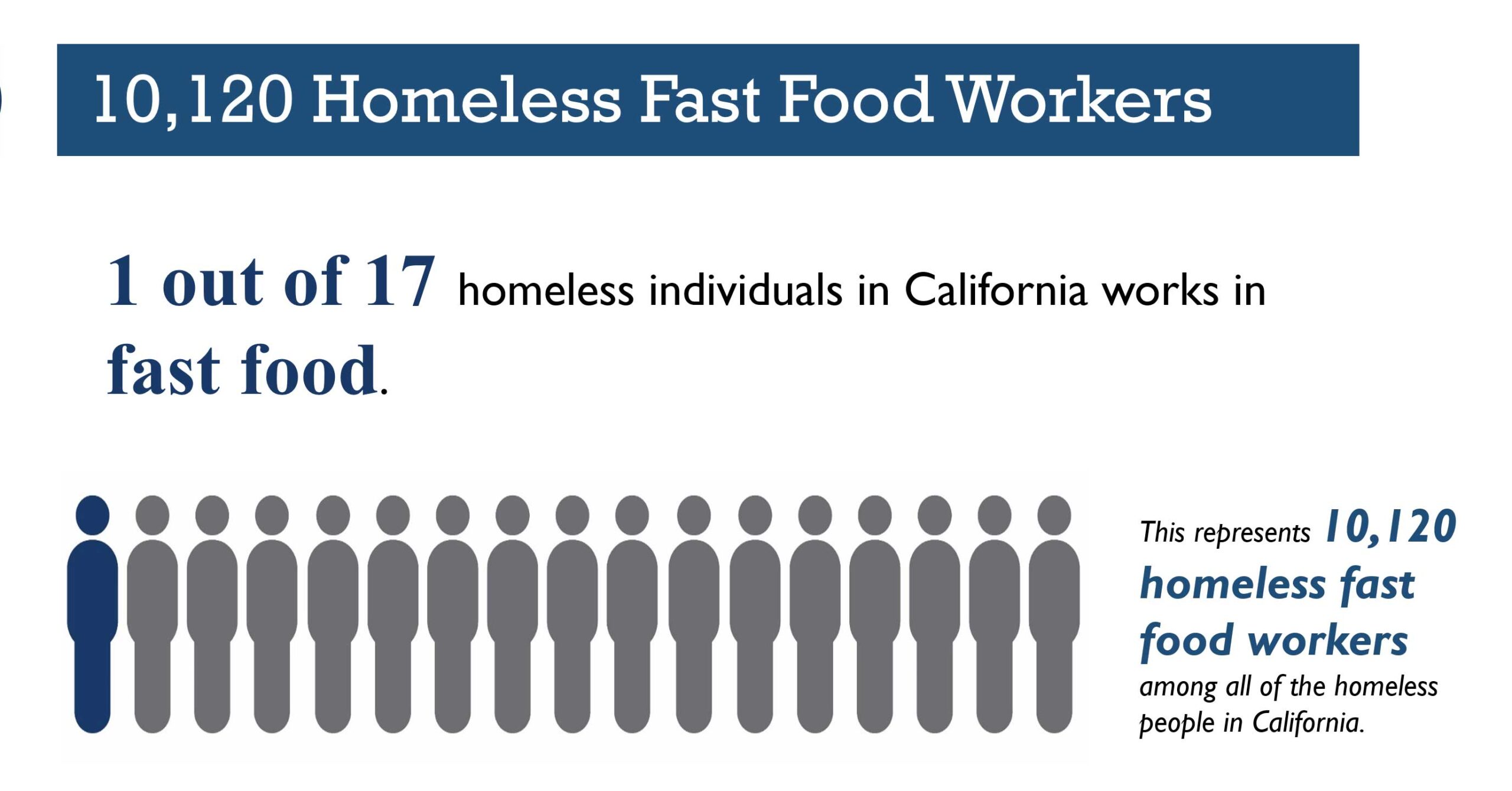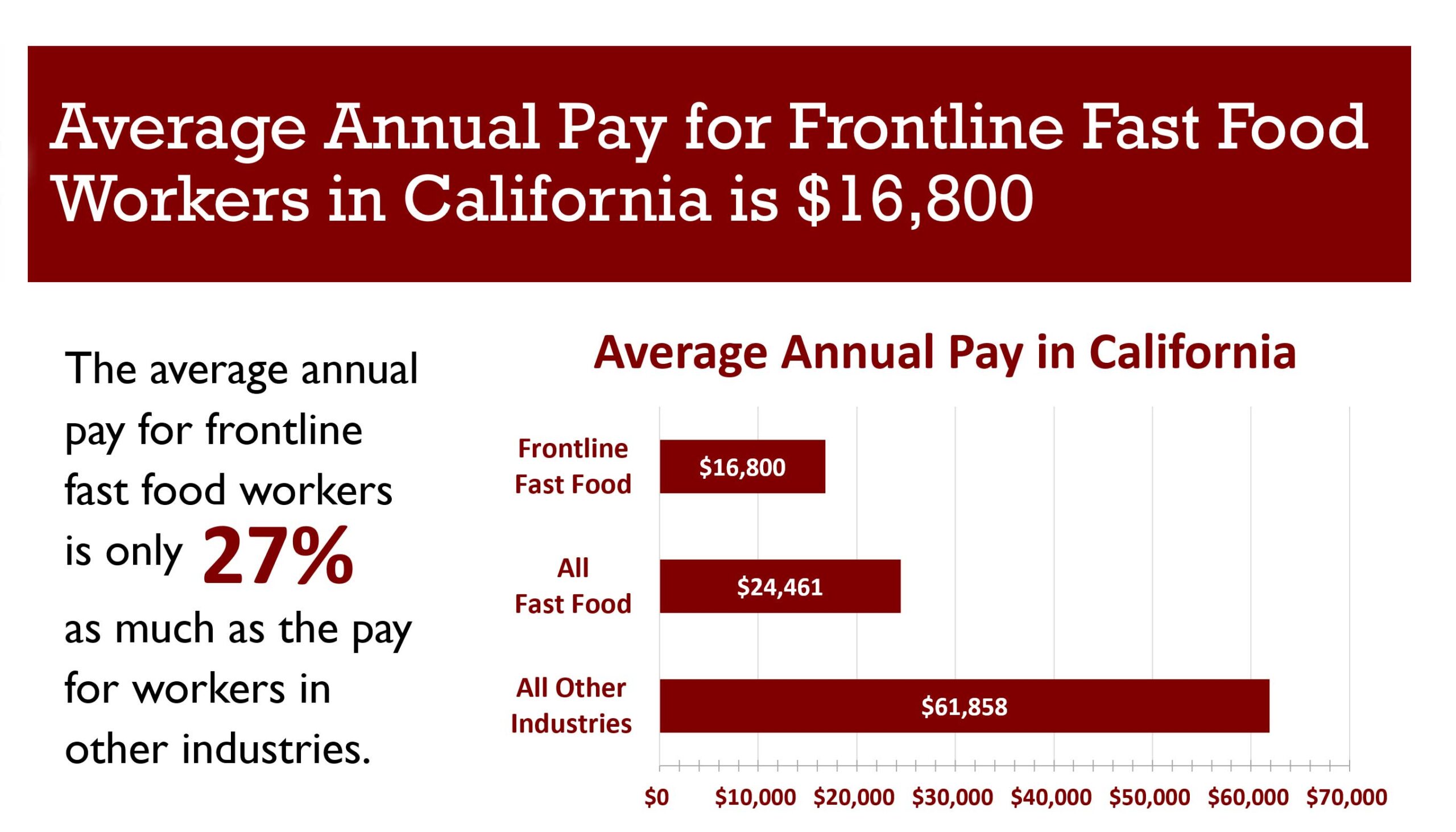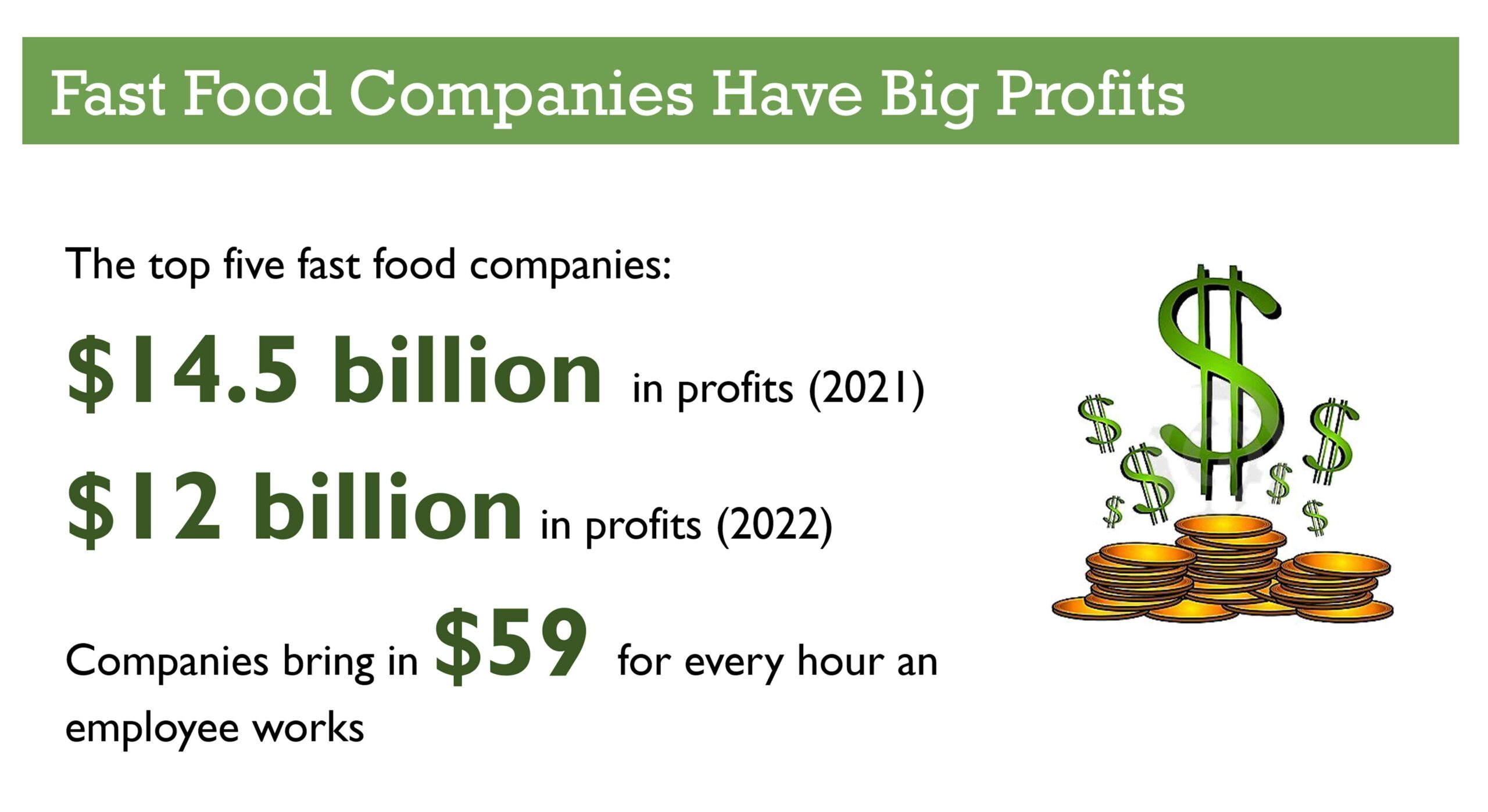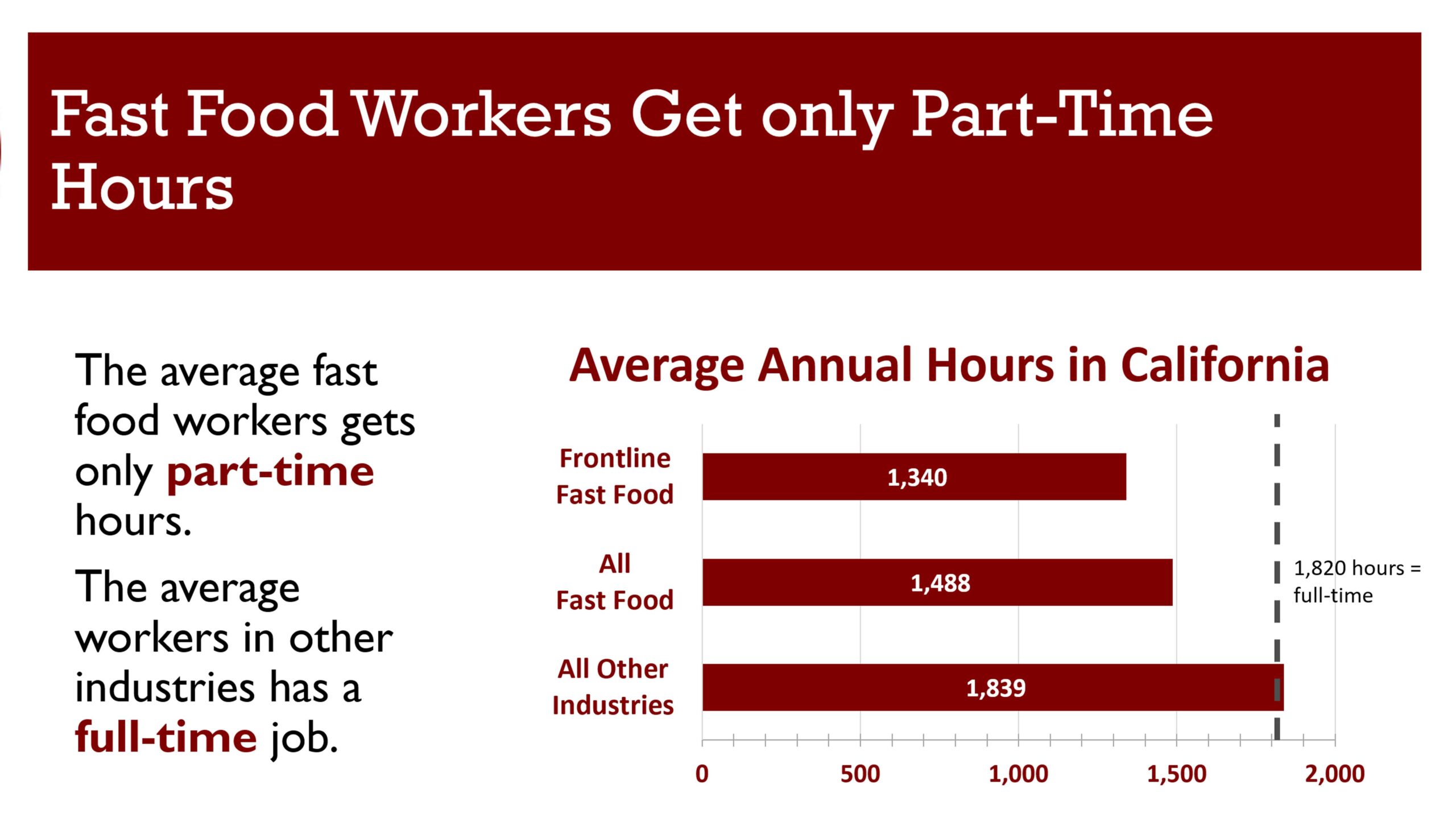Poverty Employment and Homelessness
There is a strong connection between under-employment, unemployment, poverty, and homelessness. Not having enough money to pay rent contributes to homelessness just as much as the lack of affordable housing does. Low earnings make eviction and homelessness a real risk. Good jobs are crucial for preventing homelessness.
 The fast food industry is a poverty employer, with a larger share of its workers in poverty than any other industry. All low-wage workers face some level of risk that they will become homeless. This risk is compounded in the fast food industry by the combination of low wages, part-time work and employee churn. These interlocking hazards undercut workers’ ability to pay their rent.
The fast food industry is a poverty employer, with a larger share of its workers in poverty than any other industry. All low-wage workers face some level of risk that they will become homeless. This risk is compounded in the fast food industry by the combination of low wages, part-time work and employee churn. These interlocking hazards undercut workers’ ability to pay their rent.
Fast food workers make up 11 percent of all homeless workers in California, 9 percent in Los Angeles County and 8 percent in the City of Los Angeles.
If the fast food industry provided sustaining pay and stable employment that enabled its workforce to remain housed there would be 10,120 fewer homeless workers in California, 3,595 fewer homeless workers in Los Angeles County and 1,889 fewer homeless workers in the City of Los Angeles.
California’s homeless population grew 51 percent from 2014 to 2022. We estimate that homelessness would have grown about one-fifth less in California if the fast food wage floor was adequate to ensure that workers have stable housing. Homelessness would have grown a still disastrous 42 percent, but not 51 percent.
Economic Homelessness
People become homeless for different reasons, including unemployment, families breaking up, medical or mental health problems, and substance use disorders. Unemployment is by far the most frequent explanation that homeless individuals provide when asked why they are homeless. Forty-five percent of homeless adults report that unemployment is the reason why they are homeless.
Economic homelessness emerges when workers are destitute and unable to pay rent. Poverty and inability to pay for housing are the primary cause of homelessness. We estimate that 55 percent of homeless individuals were recently in the labor force or are still working. This includes 45 percent who say they are homeless because of unemployment and an additional 10 percent who are homeless but also report that they are currently working.
We estimate that fast food workers make up 5.9 percent of California’s total homeless population, 5.2 percent of Los Angeles County’s homeless population and 4.5 percent of the City of Los Angeles’ homeless population.
Homelessness is primarily a problem of working poverty. The fast food industry is the largest poverty employer in California. Raising the wage floor in this industry is the single most important step for reducing economic homelessness in the state.
Hours and Wages
California’s frontline fast food workforce obtains an average of only 1,340 hours of paid work per year. This is 26 hours a week if they work year-round or more hours per week broken up by spells of unemployment. All of the other workers in California are employed an average of 1,839 hours a year. Full-time jobs are typical in California outside of the fast food industry.
 The average annual pay of frontline fast food workers in California was $16,800 in 2020. Over two-thirds of California’s frontline workers are paid less than $20,000 a year. The poverty rate for the households of frontline workers in California is three times higher than the rate for the rest of the state’s workers.
The average annual pay of frontline fast food workers in California was $16,800 in 2020. Over two-thirds of California’s frontline workers are paid less than $20,000 a year. The poverty rate for the households of frontline workers in California is three times higher than the rate for the rest of the state’s workers.
Public Assistance
One-third of frontline fast food workers receive taxpayer-funded health care through Medicaid. This is twice as large as the share for all other industries in California. The fast food industry increases corporate profits by transferring the health care needs of its workforce onto the public.
Roughly one-fifth of frontline fast food workers receive food stamps. The share of frontline workers who depend on food stamps to fight hunger is roughly twice as large as in all of the other industries in California.
The limited-service food industry brings a full-service appetite to the public treasury. It sells food to the public and at the same time relies on the public to pay for the food that its workers require.
Precarious Housing
Because of low wages and insufficient incomes to afford adequate homes for their families, 43 percent of frontline fast food workers in Los Angeles live in overcrowded housing. These rates of overcrowding are more than twice the rate for all of the other workers in the labor force.
 Overcrowding affects mental health, stress levels, relationships and sleep, and it may increase the risk of infectious disease.
Overcrowding affects mental health, stress levels, relationships and sleep, and it may increase the risk of infectious disease.
An additional risk is that if one of the wage earners in the household loses their job or moves out, the remaining household members may be unable to pay rent and become homeless.
A quarter of frontline workers in the City of Los Angeles spend over half of their income to remain housed. These workers are choosing between paying for household necessities such as food and clothing, and paying their rent. These fragile solutions collapse if income drops because of unpredictable work schedules, loss of a job or a large, unavoidable expense, such as a car repair to ensure transportation to work or paying for essential prescription medicine.
Unpaid rent results in eviction, and eviction can result in homelessness.
Worker Turnover
More than four out of five fast food workers were fired or quit their job in each of the last two years. The most frequent reason for quitting is low wages.
Low wages, part-time hours, on-demand scheduling, and unpredictable scheduling create and perpetuate poverty. Workers scramble between jobs to escape poverty while fighting the deprivation and housing instability caused by intermittent unemployment.
Housing becomes more precarious during the unemployed gaps between jobs as workers look for a job with better pay or working conditions. These intervals of unemployment may become windows of deeper poverty ending in homelessness. Workers who were already behind on their rent may lose their housing when they lose their job.
Closing the Pipeline into Homelessness
Every day, 665,600 fast food workers in California prepare and serve meals that bring in $59 in revenue for their employers for each hour that they are on the job. The industry can afford to do right by its workers.
 Most frontline fast food workers are precariously housed because of low wages and part-time hours. There is no floor to prevent their fall into homelessness. The 5.9 percent share of California’s homeless residents who come from the fast food labor force is a continuous stream, adding to the daily flow of new entrants into homelessness.
Most frontline fast food workers are precariously housed because of low wages and part-time hours. There is no floor to prevent their fall into homelessness. The 5.9 percent share of California’s homeless residents who come from the fast food labor force is a continuous stream, adding to the daily flow of new entrants into homelessness.
Reducing the flow of new entrants into homelessness is by far the most feasible strategy for reducing and ending homelessness. There is far less public cost and human misery in preventing someone from becoming homeless than there is in intervening after the fact with deeply subsidized housing that is costly to build and lags the level of need by decades.
The Solution
The fast food industry is thriving and has enough wealth to treat workers fairly. The top five publicly traded fast food corporations operating in California generated $14.5 billion in profit in 2021 and $12 billion in 2022.
A majority of fast food brands in California use a franchise structure that channels business risks to local franchisees while claiming a share of revenue that does not guarantee any profit for the operator. This enables the corporations to buffer themselves from responsibility for working conditions and shrinks local resources for improving the lives of workers.
The fast food industry is concentrated in a small number of brands. There are more than 30,000 fast food locations in California and the majority of them are controlled by the top 20 brands, including McDonald’s, Carl’s Jr., Subway and Jack in the Box. Less than one percent of the fast food locations in California are controlled by brands with fewer than four locations in the state.
Many top brands in California have a number of multi-unit, mega-franchisees that own dozens or even hundreds of locations. This is not an industry that is characterized by small businesses.
Poverty among frontline workers is the result of a system designed to ensure maximum profit for fast food corporations. Structural change is needed to correct structural problems.
Solutions include allowing workers to organize and have a voice in setting industry standards, bringing together corporate executives, workers and government regulators to establish industry-wide standards, and requiring corporate brands to support local franchise operators in providing wages, benefits and scheduling that enable frontline workers to afford housing, food and health care.
Press Coverage
https://calmatters.org/california-divide/2023/10/kroger-albertsons-merger/
Labor, business reach deal to end referendum over landmark California fast-food law
By Taryn Luna, Los Angeles Times (September 11, 2023)
Yes, you can be employed and homeless
By David Brancaccio and Jarrett Dang, MarketPlace Morning Report, (June 1, 2023)
McDonald’s hiring 1,000 Southern California workers this summer
By Kevin Smith, Orange County Register (May 22, 2023)
Cooking Up Poverty
By Paul Rosenberg , Random Lengths (May 11, 2023)
Low wages, short hours drive many fast-food workers into homelessness
By Andrea Chang, Los Angeles Times (May 2, 2023)
Inequality You Can Taste: Low Wages and Unstable Employment Make Fast Food Workers Susceptible to Homelessness
By Ethan Ward, Capital & Main (May 2, 2023)
An Estimated 3,600 LA County Fast Food Workers Are Unhoused, Report Finds
By David Wagner, LAist (May 2, 2023)
One in 17 homeless people in California have jobs in the fast food industry: Low wages and inability to get full-time hours to blame, study claims
By Paul Farrell, Daily Mail (May 4, 2023)
Fast food industry’s low wages help fuel California’s homeless issues, says new report
By Matthew Miranda, Sacramento Bee (May 2, 2023)
L.A. fast-food workers sound alarm on facing homelessness
By Sara Welch, KTLA 5 News (May 2, 2023)
Report: Fast food workers make up nearly 10% of LA’s homeless population
By KCAL News Staff, CBS Los Angeles (May 2, 2023)
Report finds connection between fast food work and homelessness
By Scripps News – ABC Texas and NBC Wisconson (May 5, 2023)
Fast Food Workers Make up 11% of All Homeless Workers in California and Six Percent of Total Homeless Population
By Random Lengths (May 2, 2023)
Más de 10,000 trabajadores de la industria de la comida rápida en California son desamparados
By Araceli Martínez Ortega, La Opinión(May 2 2023)
Les bas salaires et les horaires réduits conduisent de nombreux travailleurs de la restauration rapide à l’itinérance
By Nouvelles Du Monde (May 2, 2023)
LA郡ホームレス人口の9%がファストフード店勤務 低賃金と住居不足が原因
By LALALA USA (May 3, 2023)
California homeless: Fast food workers on streets
By Rachel Bluth and Alexander Nieves, Politico (May 3, 2023)
Study Finds Thousands of Fast Food Workers in Los Angeles County Homeless
By Abu Writes, News Break (May 3, 2023)
LOW WAGES IN THE FAST FOOD INDUSTRY ARE HELPING FUEL HOMELESS ISSUES IN CALIFORNIA, A NEW REPORT SAYS
Delicious Food (May 2, 202)
Eleven-Percent Of California’s Homeless Work In Fast Food
KSRO Sonoma County (May 2, 2023)
Flipping burgers — and living on CA streets
By Jeanne Kuang, CalMatters (May 3, 2023)
Más de 10,000 trabajadores de la comida rápida en California han estado sin hogar: “hemos vivido en nuestros carros”
By Dulce Castellanos, Univision (May 2, 2023)
More than 10,000 fast-food workers are homeless in California, report says
By Lisa Jennings, Restaurant Business Online (May 2, 2023)
3,600 LA County fast food workers are homeless, report shows
By Alexa Mae Asperin, Fox 11 LA (May 2, 2023)
Poverty Employer
By Soumya Karlamangla, New York Times (May 3, 2023)
Fast-food industry drives workers to homelessness, report finds
By Elizabeth Napolitano, Money Watch CBS News (May 3, 2023)
One in 17 homeless people in California has a job in the fast food industry
By Emma Colton, WST Post (May 2, 2023)
More fast food workers fear homelessness
By Our Weekly (May 4, 2023)
Report: 10% of LA’s Homeless Are Fast Food Workers
By The Workers Rights (May 3, 2023)
One In 17 Homeless People In California Has A Job In The Fast Food Industry
By NY Breaking (May 5, 2023)
The minimum hourly wage in California’s catering industry may rise to $22
By Redian News (May 17, 2023)
Broadcast Coverage of Hungry Cooks
A dire picture of fast food
By Spectrum News 1 (May 23, 2023)
1 in 9 homeless California workers is employed in the fast food industry
By KNX-AM Los Angeles (May 7, 2023)
New Report Details Homelessness in CA Fast-Food
By Josh Haskell, ABC – LA (May 3, 2023)
Homelessness Among CA Fast-Food Workers
By Chris Sedens, KNX News Radio LA (May 2, 2023)
Fast Food Workers Demand Higher Wages
By Cristy Fajardo, Fox 11 LA (May 2, 2023)
New Report: Low Wages and Short Hours Drive Homeless in Fast-Food
By Spectrum News 1 (May 2, 2023)
Fast Food Workers in Poverty
By Kristine Lazar, KCAL News (May 2, 2023)
Report: 3,600 Fast Food Workers Are Homeless
By Fox 2 News Bay Area (May 2, 2023)
Homelessness Among CA Fast Food Workers
By Chris Sedens, KCBS Radio Bay Area (May 2, 2023)
Many Homeless are Fast Food Workers
By Megan Hammer, KFBK Radio Sacramento (May 2, 2023)














